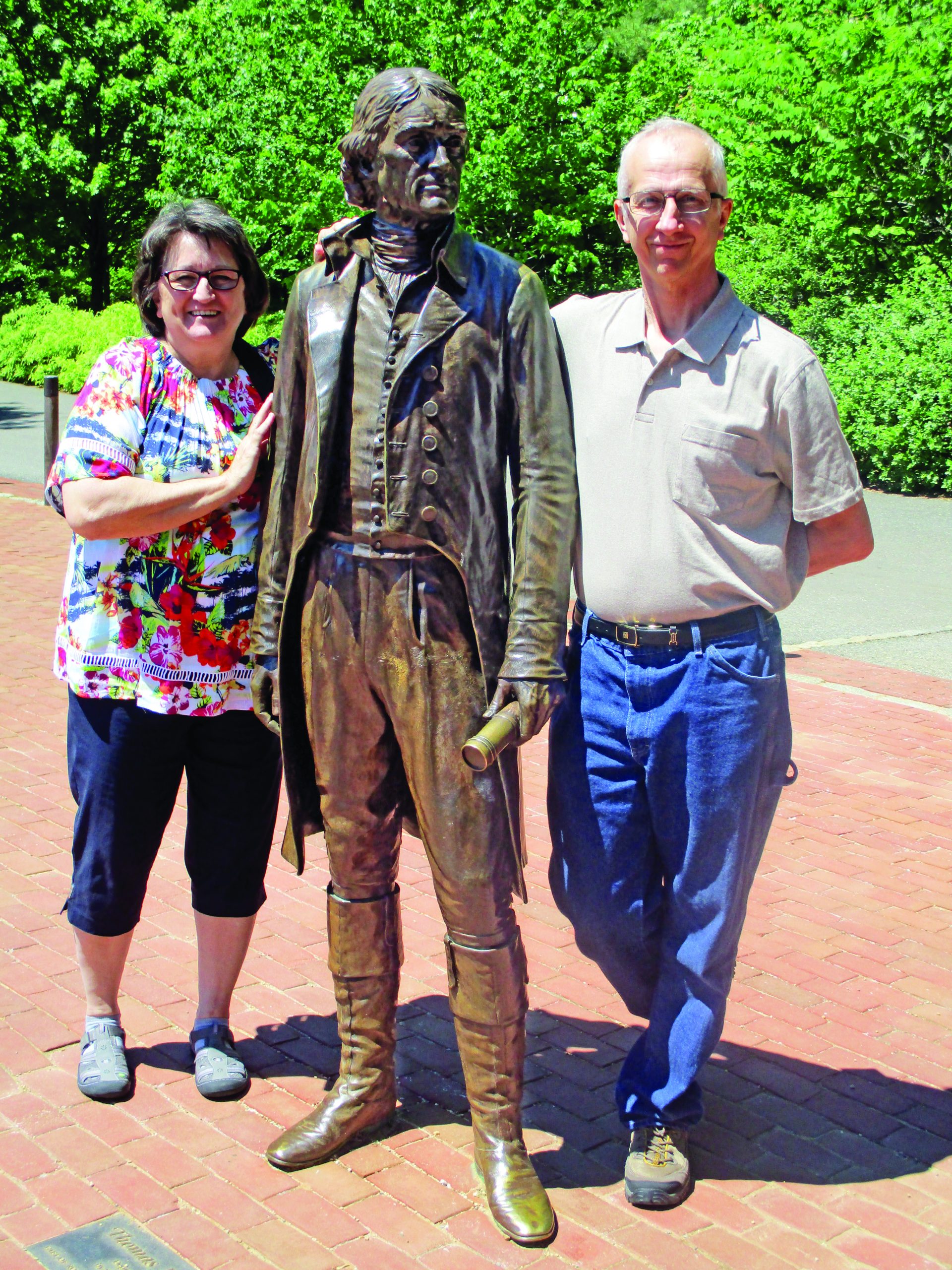COUNCIL BLUFFS, Iowa — The sad Biden squad sat in the front row of the auditorium at Longfellow Elementary School. The rowdy Bernie crew stood in the back, a bit disoriented because its precinct captain didn’t show. Warren supporters had claimed the corner by the front door, almost as if they were running the caucus. The Buttigieg contingent, run by a gregarious college woman in the ROTC, occupied most of the left half of the auditorium.
The back-left corner housed the Yang Gang. They were 10 young voters. It was the first time caucusing for all of them except for Ryan Miller, who had caucused for Bernie Sanders in 2016.
Then, in the large expanse between the lavender-themed Warrenland and the blue Bernieland, was a single bright-green hat atop the head of Miller’s wife, Emily, who sat with their daughter Lucy, a student at Longfellow.
The green hat looked like a visual declaration of independence. Emily Miller didn’t show up at the request of any campaign. Her parents were caucusing as Republicans. She wasn’t about to follow her husband into the Yang Gang. She had backed Sanders four years ago, but now, she had a different idea of who the best candidate was.
In this room of 80 voters, there were four Klobuchar backers, a couple of Steyer supporters, and two undecided voters. Emily, and only Emily, showed up to caucus for Deval Patrick.
It’s an independent streak that runs in her family — a family that over the years has caucused for John Edwards, John Kerry, Rand Paul, Donald Trump, and even Joe Biden. Such independence is actually rare, but sometimes it makes a difference.
‘Why are we for Biden?’
I first met Emily’s family years ago at Kirn Middle School, about a 10-minute drive away from Longfellow Elementary. Emily had to work that night and couldn’t show, but her little sister, Elle Jacobs, was there, at her first caucus. Elle was standing in another sad Biden corner, along with Elle’s and Emily’s mother and stepfather, Brenda and Bob Krivanek, plus a neighbor new to Iowa whom Brenda had dragged along.
As in the south-side precincts that would gather at Longfellow Elementary in 2020, Biden was not viable in the Krivaneks’s precinct in 2008. To win any delegates from a caucus, a candidate must have 15% of the voters in the precinct. Biden had 13 supporters in that room of 168 voters, where 26 was the viability threshold.
So, what made the Krivaneks pick this minor candidate in the year of Barack Obama, Edwards, and Hillary Clinton? “He has a good exit strategy for getting us out of the war with honor,” Bob said, explaining his support for Biden. “He’s not tied to any of those lobbyist groups.”

Throughout my years spent covering the caucuses (my first visit reporting was in 2002), I’ve met dozens of couples where one of the two seems to call the political shots. It’s split pretty evenly, whether it’s the husband or the wife. With Bob and Brenda, the dynamic is clear. He doesn’t always follow her lead, but he often does.
In 2008, backing Biden was her call. “Honey,” Bob said as Brenda walked over, “why are we for Biden?” Brenda, like Bob, would cite Biden’s years of experience on the Foreign Relations Committee, expressing hope that in Afghanistan, Biden could navigate between retreat and perpetual war.
But neither Bob nor Brenda was much of a Democrat. Bob said his second choice in 2008 was Mitt Romney. So, why did they attend the Democratic caucus, when just down the hall, the Republicans had their own exciting caucus featuring Mike Huckabee, John McCain, and Romney?
“It was mostly Biden” who got them in that room that day, Brenda would tell me years later. “I really thought he was the only one who could get us out of Afghanistan … and Iraq.”
So, when Biden was unviable in 2008, neither Bob nor Brenda had any desire to switch to a viable candidate. The Hillary contingent, which was the largest after the first count, chanted “Hil-la-ry! Hil-la-ry!” Obama’s group led a cheer: “Join O-ba-ma! [Clap, clap, clap-clap-clap!].” A woman across the auditorium held up a box of cookies and shouted, “Do you guys want some cookies? Come to Edwards!”
Slowly, the voters who had originally backed Biden, Chris Dodd, Dennis Kucinich, and Bill Richardson settled on one of the major candidates, mostly Obama and Edwards. When one conservative fireman, declaring Dodd-or-bust, headed for the exits, and when the Krivaneks’s neighbor aligned with her second choice, Edwards, there were three undecideds left: Bob, Brenda, and Elle.
They didn’t know that at that moment, but their caucus could not possibly have been closer. Edwards had caught Clinton, and both were at 55 votes, while Obama was at 54. This crew would pick the winner.
But Bob and Brenda had no interest in doing so. “That’s it for me,” Bob said. “It’s Biden or nothing.”
He and Brenda were ready to leave, but Elle, quiet until now at her first-ever caucus, piped up. “Mom, I’m going over there,” she said nervously.
She wasn’t joining the candidate who attracted most of the youth vote, Obama. She wasn’t joining the supposed woman’s candidate, Clinton. Elle crossed the room to the Edwards corner. The room erupted in cheers, the chairmen counted the votes and announced the result: Edwards, 56, Clinton, 55, and Obama, 54.
Elle, by breaking from her parents and from the media’s idea of how either a woman or a young person should vote, had delivered the precinct to Edwards. This was a two-delegate swing for a race in which Clinton would come in third statewide, trailing Edwards by less than a percentage point.
True independent
Ever since the night Elle Jacobs sank Hillary Clinton, I’ve kept in touch with the family. They introduced me to fried pickles when we grabbed drinks in 2012. In 2016, Brenda organized something of a focus group for me, bringing in four other couples and reserving the big backroom at Tish’s Restaurant.
When you talk to enough voters, you meet a hundred self-proclaimed independents who, when pressed on voting history, reveal themselves to be either Republicans or Democrats who just don’t want to admit that. Brenda Krivanek is no phony independent. In the 1990s, she voted for Ross Perot. Then she voted for Ralph Nader twice. And in 2008, she showed up to caucus for Biden. When Obama got the nomination, she and Bob voted for McCain.

Come 2012, Biden had lost his sheen to them, and they caucused as Republicans. In 2016, they were both undecided on caucus night. Both were considering Chris Christie, while Brenda was also looking into Paul, and Bob was eyeing Trump.
Bob’s and Brenda’s votes sound all over the place, but their beliefs and values are pretty consistent. Driving around Iowa in the days before the 2020 caucuses, I listened to the recordings of our on-the-record conversations over the years. Both consistently sought someone who would extract the United States from its wars in the Middle East. Brenda has said since at least 2012 that Republicans need to care more about the environment. She has also worried that uncontrolled immigration would strain government finances and harm the working class.
Both have consistently looked for politicians “not tied to any of those lobbyist groups” or who “can’t be bought.” They both have, throughout the years, expressed distaste for pandering and rank partisanship. In other words, they’ve valued independence.
They wanted politicians who made up their own minds, rather than letting party, polls, or special interests predetermine their answers. “I can’t stand Rubio and Cruz,” Brenda said just before the 2016 caucuses, “because they’re so panderish.”
Christie appealed to both Krivaneks because his brash style seemed to reflect a don’t-give-a-fig attitude. Paul’s libertarianism, stubbornness, and anti-establishment pedigree appealed to Brenda. And Bob liked Trump because of his obvious independence from just about everything: big-money donors, the party establishment, and elite opinion. Nobody tells Trump what to think.
That’s a good thing to Bob. Bob is a union man. He’s retired from the Council Bluffs city government. His beef with state-level Republicans such as Gov. Kim Reynolds is their efforts to strip public sector unions of power.
In 2016, Bob attended a meeting of the local AFSCME chapter, where the union bosses got up and explained that AFSCME was endorsing Clinton in the caucuses and why Bob and the others should caucus for her. Unions are famous for commanding loyalty and voting as a bloc: Back in 2008, the firemen in Council Bluffs voted uniformly for Dodd, and then they almost uniformly realigned for Obama. But the union’s argument didn’t persuade Bob one bit. He caucused as a Republican and stood in the Trump corner. Brenda, in the same room, voted for Rand.
They’re voters who are always going to make up their own minds, and they want politicians who will do the same. And so Bob and Brenda have never held it against family members who disagree, sometimes strongly.
Kerry, Sanders, Yang, Patrick, and Warren
Elle’s exciting political debut didn’t turn her into a politico. In our 2016 informal focus group at Tish’s, Brenda apologized. “I tried to get Elle to come tonight, but she’s totally not interested. She couldn’t care less.”
Emily, on the other hand, is an active Democrat. In 2004, she caucused for Kerry. She missed 2008 for work. Come 2016, Emily and Ryan got behind Bernie big-time. Emily’s main reason: “He doesn’t take money from corporations.” Ryan explained that he likes Sanders’s consistency, that you knew he was acting on true belief.
That fall, Emily and Ryan held their noses and voted for Clinton. Bob voted for Trump. Brenda didn’t. “I can’t vote for Trump. I think he’s a total idiot,” she told me. So, she voted Jill Stein.
A couple of weeks before the 2020 caucuses, Bob told me he planned to show up at the GOP caucuses to support Trump. Emily and Ryan said they were torn between Elizabeth Warren and Sanders.
But things changed before caucus day. Ryan learned more about Andrew Yang, and joined his gang. Emily took an online questionnaire at the Washington Post, and the candidate she aligned with most was Patrick, whom she knew nothing about.
That’s how she ended up alone, with little Lucy, in the auditorium. When it became clear Yang was just short of viability, Emily considered going to Yang, to support her man. But one vote wouldn’t do the trick, so she settled for Warren instead, which pleased Lucy, who had decided Warren was best.
Ryan had to make a choice now. He was about to join his wife with Warren when two Bernie backers intercepted him and made their case. Ryan paused for a minute and made up his mind: Sanders again. Emily was neither upset nor surprised. “He still has the Bernie sticker on his car” from 2016, she told me.
The final count in the room was disputed. The party officials said Pete Buttigieg won, beating Sanders by two votes. By the count Buttigieg’s precinct captain kept, he beat Bernie by one vote. Sanders’s de-facto precinct captains argued it was a tie.
Depending on which count you use, Emily’s decision to not return to the Sanders fold may have handed Buttigieg the precinct, or Ryan’s decision to not follow his wife to Warren might have prevented a Buttigieg victory and brought about a tie.
As the night ended, and I bid farewell to Emily and Ryan for another four years, little Lucy waved her Warren sign. She’ll be able to caucus with her parents in 2032. Though maybe by then, she’ll be a Republican.
Timothy P. Carney is a senior political columnist at the Washington Examiner.

